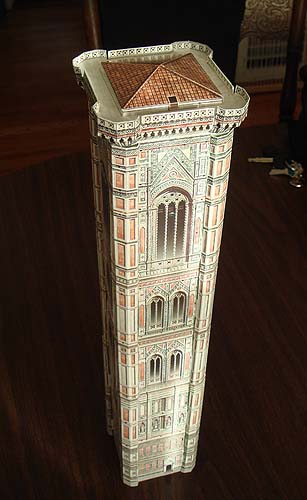This was an easy kit also except for the roof - there are some complex curves and folds at the corners of the roof that were a little hard to fold and glue.

(the following is the quoted text from the folder that came with the paper kit)
"The bell tower that rises directly out of the pavement of Florence's Duomo square forms the focus of the system of exterior spaces around Santa Maria del Fiore and the Baptistry. One of the town criers' rhymed announcements (Antonio Pucci's «Centiloquio») reported that the cornerstone of the new campanile of Santa Reparata was laid on July 19, 1334, «breaking every bush...». Also, it recorded that Giotto worked on the first carvings at the base «in a beautiful style». The Master started what was to be his last work at the age of seventy and died in 1337. He is buried in the church. His original idea was recovered when a large parchment was found during the past century at the Siena Cathedral. On it is a colour drawing of what most scholars have now come to recognize as Giotto's true bell tower design. It features square backgrounds dotted with hexagons, pierced by openings that increase in size nearer the top, like the Romanesque campaniles. This accents verticality. It is crowned by an octagonal element with a pyramidal spire bordered with white prafiles. The drawing on the Sienese parchment perfectly matches the first stage executed by Giotto and it probably tells us where his successor stepped in.
"Goaded by an anonymous commentator on Dante, who declared that Giotto's base was badly proportioned, Andrea Pisano felt he had the right to depart from the initial scheme. After having sculpted some panels for the lower stage, Andrea doubled its height by adding a second row of panels. Above this section he made the campanile slightly narrower and divided each face by means of two pilaster strips that would have related to Giotto's octagonal cap.
"The only (undocumented) motives for having Andrea removed were the hostility of Taddeo Gaddi, one of Giotto's faithful disciples, and the fact that Andrea's patron, the Duke of Athens, was dethroned in 1343.
"Francesco Talenti's name appears on a 1351 receipt for marble delivered
to the construction site where he was the master builder from 1350 to
1359. The new architect did his best to return to Giotto's original design,
without demolishing what had been erected previously. He undertool, a tricky,
unbridled interpretation of the Sienese parchment’s coherent design,
apparently constantly utilizing it to guide his work; Talenti even followed
its suggestions in the design of the marble decorations.
"An interesting question concerning the history of this monument is: what
was the Cathedral Giotto designed his campanile for supposed to have been
like? Arnolfo's scheme, with a plan having nearly the same dimensions
as today's structure but a different interior layout, was «approved» by
Giotto, for he painted its facade in one of the frescoes, The weaping
Clarisses, in the upper church at Assisi. Yet
the Cathedral grew higher in time and its proportions changed, influencing
the campanile's architects. Likewise, having the bell tower standing
to the right of the Duomo led the designers to narrow the bays and made
the square module obligatory in order to maintain the necessary proportions.
So Andrea Pisano, the architect of the first revised church design, doubled
the number of bays envisaged by Arnolfo and decided to modify the height
of the bell tower so it would suit the revamped church size.
"Talenti, influenced by the new 1357 revision which cut the bays from four to three and made the building even higher, was forced to work on two different campanile designs simultaneously. It had to be made still taller; in creating the top story, with linguistic anomalies that Giotto could not have imagined, he had to fall back on a compromise.
"The current top, 84.70 meters high, has a projecting balcony; this device was later extended to the entire Cathedral facade, becoming one of its stylistic peculiarities. Actually, it was merely Talenti's base for the envisioned crowning spire which was never built, because the church had to be finished first; then, at a later date, tastes had changed. Thus what was supposed to have been a base for a Giottoesque cap, and therefore was only a temporary arrangement, has turned out to be a satisfactory roof. Now it has definitely become part of the general image of Florence's campanile."
Send
email to Bob at electricbob@alephnaught.com
Send
email to Aviva at avivakramer@earthlink.net